Careers at CDC
CDC Microbiologists
Microbiologists at CDC work in four centers: NCHSTP, NCID, NCEH, and COTPER, and their roles vary widely. For example, a CDC microbiologist may be anyone from a technician with a bachelor′s degree or the equivalent, to an independent researcher, to a supervisor, who normally would have a doctorate. As one might expect, their duties depend upon their level of training and experience. These duties range from performing basic microbiological procedures and techniques under supervision, to developing creative methods for solving problems, developing protocols and tests, conducting experiments, writing manuscripts, and supervising staffs.
Read on to meet some of the many and varied microbiologists working at CDC today.
Henry S. Bishop
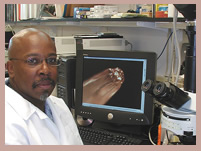
Microbiologist, Division of Parasitic Diseases, NCID
Anyone who thinks a career in science is dull hasn′t met Henry Bishop. Bishop′s work runs the gamut from performing diagnostic evaluations of specimens in the reference lab to assisting in the Malaria Branch by maintaining colonies of mosquitoes for research to being part of the DPDx project.
"DPDx is an Internet-based vehicle for diagnosing and teaching parasitology," Bishop explained, his enthusiasm for the program is evident. "We also travel to conduct workshops aiming to strengthen public health laboratories′ ability to diagnose parasitic diseases." The DPDx project includes a website which is constantly evolving, because information on diagnostic parasitology changes, e.g. new facts on emerging parasites, so it is an ongoing project. "I have been involved in epi-aid work of a broad spectrum of parasitic diseases, particularly foodborne outbreaks," he added.
Bishop spent eight years in the US Air Force as a veterinary technician/environmental health technician before coming to CDC in 1983. He has twice received the Secretary′s Award for Distinguished Service (1997, 2001), received the Superior Work Performance Award in 1988, and was a nominee for Federal Employee of the Year, Technician/Assistant in 1986.
Matthew Jennings, MT (ASCP), MS, CBSP
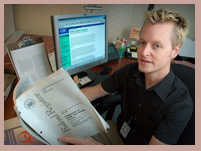
Microbiologist, Division of Select Agents and Toxins, COTPER
"I am a nontraditional microbiologist in the sense that I do not currently work in a laboratory environment," explained Matthew Jennings. A microbiologist with the CDC Select Agent Program, Jennings′ duties are primarily regulatory.
CDC regulates possession, use, and transfer of select agents and toxins that can pose a severe threat to public health and safety. Jennings is currently responsible for approving registrations for entities working with these agents, as well as permits to import etiologic agents of human disease.
A clinical microbiologist in Atlanta-area hospitals since 1996, Jennings worked at CDC in 2003 as a contractor and was hired full-time in 2004. Earlier this year, he worked on a team led by DSAT′s Chief of Policy, Mark Hemphill, in the publication of the select agent final rule. "I was delighted later in June to receive a letter of commendation from CDC Director Dr. Gerberding, along with the other team members," he said.
Amy Lambert
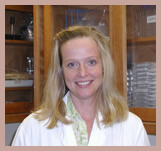
Microbiologist, Arbovirus Diseases Branch, Division of Vector-Borne Infectious Diseases,
Fort Collins, Colorado, NCID
"I feel incredibly fortunate to be a part of CDC and I am grateful to come to work here every day," is the way Amy Lambert explained her reasons for working at CDC. She has worked in her field for seven years, all of them at CDC, where she began as a student volunteer from Colorado State University in 1998.
Recently, Lambert has been working on development of a quantitative real-time RT-PCR assay for the detection of Colorado tick fever virus. Her experience as part of CDC′s 1999 response to the West Nile Virus outbreak stands out as the most rewarding thus far, Lambert said.
Taronna R. Maines, PhD
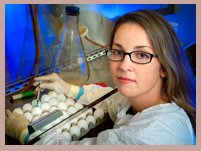
Microbiologist, Influenza Branch, Division of Viral and Rickettsial Diseases, NCID
Taronna Maines, PhD, has been deeply involved in the investigation of avian influenza at a relatively early stage in her career as a microbiologist. In January of 2006, she was deployed to Vietnam as a member of a WHO team sent to investigate an outbreak of highly pathogenic avian flu.
Maines has been at CDC for only four years, the first two as a post-doctoral fellow. The focus of her research at CDC today is "to better understand the biologic and molecular basis of pathogenicity and transmissibility of human and avian influenza viruses."
Maines said she feels privileged to work with the talented group of individuals who make up the Influenza Branch. "Having the extraordinary opportunity to work with this team during such a critical time for influenza in the world today is an experience that I expect will be unparalleled in my career," she said.
William M. Switzer, MPH
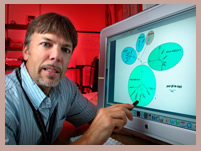
Non-HIV Surveillance Activity Leader, Laboratory Branch, Division of HIV/AIDS Prevention, NCHSTP
Bill Switzer, MPH, currently leads his branch in the study of simian retrovirus emergence among people who are exposed to primates during the course of their work and is a well-recognized authority in the field. Switzer joined CDC in 1986 but had been interested in its work since studying public health microbiology as an undergraduate.
He was instrumental in documenting simian foamy virus infection in a natural setting among primate hunters in Cameroon, showing that simian retroviruses are actively crossing to humans. This work was published in Lancet and has received considerable recognition by media and scientific outlets. Switzer said he is proudest of his work in this area along with identification of two other new human retroviruses, HTLV-3 and HTLV-4 (human T-cell lymphotrophic/leukemia virus types 3 and 4), which was published in PNAS in May.
Switzer has received numerous professional awards; the most recent is the 2004 NCHSTP Honor Award.
Amilcar Tanuri, MD, PhD
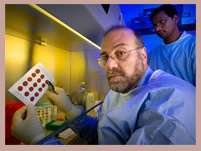
Senior Service Fellow, Global AIDS Program, NCHSTP
The Global AIDS Program (GAP) has 25 country programs and four regional offices around the world to help resource-constrained countries prevent HIV infection; improve treatment, care and support for people living with HIV; and build capacity and infrastructure to address the global HIV/AIDS pandemic. Microbiologists play an important role in this effort.
"The major effort of our group is to make sure Africans will be treated and make a difference in the AIDS epidemic in the African continent. The most important thing is that in this brick wall, I will put a small brick," said Amilcar Tanuri, MD, PhD. "The task is much bigger than the person."
Heading the effort to implement early diagnosis of African infants exposed to HIV, Tanuri is experiencing the building of the brick wall against AIDS first-hand. He has worked in Rwanda, Angola, Mozambique and Botswana.
His work involves evaluating new technologies and implementing new programs to fight AIDS in Africa. He is working as part of the President′s Emergency Plan for AIDS Relief to help Mozambique and Rwanda establish a laboratory network to monitor the treatment of AIDS patients in those countries.
David L. Trees, PhD
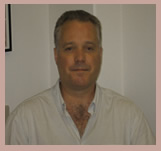
Lead, Gonorrhea Molecular Epidemiology and Reference Lab, Laboratory Reference and Research Branch, DSTDP/NCHSTP
Microbiology and Pontiac GTOs are shared passions for David Trees, PhD, and his wife, Eija, who also works at CDC as a research microbiologist in PulseNet. Trees himself works in the Laboratory Reference and Research Branch, within the Division of Sexually Transmitted Disease Prevention, studying microorganisms that cause sexually transmitted infections such as gonorrhea, chlamydia, chancroid, and syphilis.
Trees joined CDC 15 years ago and believes that CDC offers a microbiologist "the rare opportunity to combine scientific research with public health."
"My team acts as the national reference laboratory for gonorrhea," explained Trees. "This involves both identification testing and antimicrobial susceptibility testing. The group is also involved in numerous antimicrobial resistance studies in which we provide molecular typing techniques to help determine relatedness of resistant isolates."
Ming (Mindy) Zhang, MD
Research Microbiologist, Inorganic Toxicants and Nutrition Branch, Division of Laboratory Sciences, NCEH
The only microbiologist in her Branch, Ming (Mindy) Zhang, MD, started working at NCID in 1997 and switched to NCEH in 1999. She has worked on B-vitamin related assays.
Zhang grew up in Beijing with the dream of becoming a doctor. She received an MD at Beijing Medical University, China, in 1987 and an MS from its Department of Pathology in 1990. Her postdoctoral training was at Cold Spring Harbor Lab, NY, and Emory Medical School, 1990—1996. "I decided to come to the US for more challenge," she said, "I am happy with my decision."
In February 2004, Zhang received the NCEH/ATSDR Director′s Employee of the Month Award, and also in 2004 she was part of the International Micronutrient Laboratory group that received the NCEH/ATSDR Superior Mission Response for an Established Event or Program.
Get email updates
To receive email updates about this page, enter your email address:
Contact Us:
- Centers for Disease Control and Prevention
1600 Clifton Rd
Atlanta, GA 30333 - 800-CDC-INFO
(800-232-4636)
TTY: (888) 232-6348
24 Hours/Every Day - cdcinfo@cdc.gov

